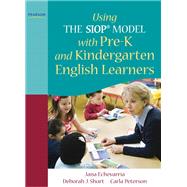
What is included with this book?
Jana Echevarría is a Professor Emerita at California State University, Long Beach. She has taught in elementary, middle, and high schools in general education, special education, ESL, and bilingual programs. She has lived in Taiwan, Spain and Mexico. An internationally known expert on second language learners, Dr. Echevarría is a Fulbright Specialist. Her research and publications focus on effective instruction for English learners, including those with learning disabilities. Currently, she is Co-Principal Investigator with the Center for Research on the Educational Achievement and Teaching of English Language Learners (CREATE) funded by the U.S. Department of Education, Institute of Education Sciences (IES). In 2005, Dr. Echevarría was selected as Outstanding Professor at CSULB.
Deborah J. Short is a professional development consultant and a senior research associate at the Center for Applied Linguistics in Washington, DC. She co-developed the SIOP® Model for sheltered instruction and has directed national research studies on English language learn-ers funded by the Carnegie Corporation, the Rockefeller Foundation, and the U.S. Dept. of Education. She recently chaired an expert panel on adolescent ELL literacy. As the director of Academic Language Research & Training, Dr. Short provides professional development on sheltered instruction and academic literacy around the U.S. and abroad. She has numerous publications, including the SIOP® book series and five ESL textbook series for National Geographic/Hampton-Brown. She has taught English as a second/foreign language in New York, California, Virginia, and the Democratic Republic of Congo.
Carla Peterson is a professor in the Department of Human Development and Family Studies and the Associate Dean for Research and Graduate Studies for the College of Human Sciences at Iowa State University. Dr. Peterson earned a Ph.D. at the University of Minnesota. She has worked in early care and education for 35 years as a teacher, administrator, teacher trainer, and researcher. She has worked in child care, Head Start, and early childhood special education settings. Her research and teaching have focused on designing interventions to meet children’s individual needs within inclusive settings.
Chapter 1 The SIOP Model and Young Children
What is the SIOP Model?
The SIOP Model: 8 Components and 30 Features
Research-Validated Approach
SIOP Professional Development
Concluding Thoughts
Chapter 2 Getting to Know Young English Learners and Early Childhood Programs by Carla Peterson, Gayle J. Luze, Molly Luchtel and Emily Worthington
Young Children and How They Grow
English Learners in Early Care and Education
Challenges in Early Childhood Instruction
Changing Landscape of Early Care and Education
Concluding Thoughts
Chapter 3 Language Development in Young Children
How Is Language Learned?
Language Register
Language Purposes
Teacher Roles in Language Development
First (Home) Language Development
English Language Development
Academic Language
Language Assessment
Parents As Partners
Supporting Children with Disabilities
Concluding Thoughts
Chapter 4 Using the SIOP with Young Learners: Lesson Preparation, Building Background
Components of the SIOP Model
Lesson Preparation
Building Background
Concluding Thoughts
Chapter 5 Using the SIOP with Young Learners: Comprehensible Input and Strategies
Components of the SIOP Model
Comprehensible Input
Strategies
Concluding Thoughts
Chapter 6 Using the SIOP with Young Learners: Interaction and Lesson Delivery
Components of the SIOP Model
Interaction
Lesson Delivery
Concluding Thoughts
Chapter 7 Using the SIOP with Young Learners: Practice & Application and Review & Assessment
Components of the SIOP Model
Practice & Application
Review & Assessment
Concluding Thoughts
Chapter 8 Implementing the SIOP Model in Preschool and Kindergarten: Sample Programs
Columbus Junction, Iowa
Veterans Memorial Elementary School, Rhode Island
AppleTree Institute for Education Innovation Partnership, Washington DC
Concluding Thoughts
Chapter 9 Best Practice Using the SIOP protocol to Support Teachers
Best Practices in Using the SIOP Protocol
Lesson Observation
Teacher Self-Reflection
Professional Development
Guidelines for Using the SIOP Protocol in Early Childhood Settings
Benefits of Using the SIOP Model and Protocol
Using the Comments Feature on the SIOP® Protocol
Reliability and Validity of the SIOP®
Concluding Thoughts
Appendix A: The SIOP Protocol: Full Version, Short Version, SIOP Checklist
The New copy of this book will include any supplemental materials advertised. Please check the title of the book to determine if it should include any access cards, study guides, lab manuals, CDs, etc.
The Used, Rental and eBook copies of this book are not guaranteed to include any supplemental materials. Typically, only the book itself is included. This is true even if the title states it includes any access cards, study guides, lab manuals, CDs, etc.